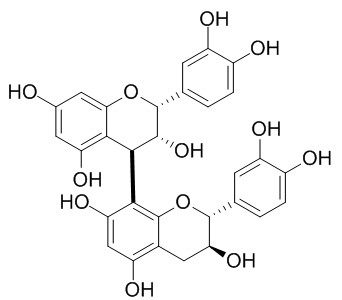Natural Products
Procyanidin B1
| Catalog No. | CFN99557 |  |
| CAS No. | 20315-25-7 | |
| Molecular Weight: | 578.52 | |
| Molecular Formula | C30H26O12 | |
| DBs | [PubChem]:274950596 [ChEMBL]:75633 [PCIDB]:9075 |
Standard InChI:
InChI=1S/C30H26O12/c31-13-7-20(37)24-23(8-13)41-29(12-2-4-16(33)19(36)6-12)27(40)26(24)25-21(38)10-17(34)14-9-22(39)28(42-30(14)25)11-1-3-15(32)18(35)5-11/h1-8,10,22,26-29,31-40H,9H2/t22-,26+,27+,28+,29+/m0/s1
Biological Activity
Procyanidin B1, one of the major components of Flavangenol, also suppresses fat accumulation and induced mRNA expression of the fatty acid oxidative enzymes.[1]
Procyanidin B1 suppresses HCV RNA synthesis, possibly as a HCV RNA polymerase inhibitor, it might contribute towards the development of more effective inhibitors for HCV infection from natural plants.[2]
Procyanidin B1 has neuroprotective effects, may attenuate the activation of caspase-3 by inhibiting that of caspase-8 and -9. [3]
Procyanidin B1 has anti-inflammatory effect on LPS-treated THP1 cells via interaction with the TLR4–MD-2 heterodimer and p38 MAPK and NF-κB signaling.[4]
Procyanidin B1 strongly inhibits the proliferation of HeLa S3 cells. [5]
Product
References
[1] Sano A, Yamakoshi J, Tokutake S, et al. Biosci Biotech Bioch, 2003, 67(5):1140-3.
[2] Li S, Kodama E N, Inoue Y, et al. Antiviral Chem Chemoth, 2010, 20(6):239-48.
[3] Kanno H, Kawakami Z, Tabuchi M, et al. J Ethnopharmacol, 2014, 159:122–8.
[4] Jing Xing, Rui Li, Nan Li,et al. Mol Cell Biochem, 2015, 407(1-2):89-95.
[5]Okamoto S, Ishihara S, Okamoto T, et al. Molecules, 2014, 19(2):1775-85.
[6] Zhao C Y, Wang M, Zhang G W, et al. J Shenyang Pharm Univ, 2014, 31(1):32-5.
Product Use Citation





